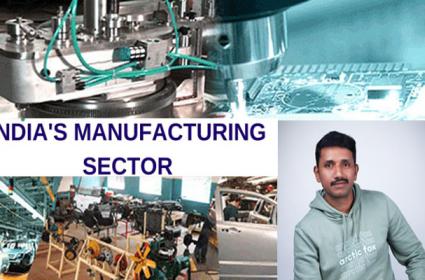Growth Drivers Of The Indian Manufacturing Sector

By Sridhar Thirunakara, Founder and MD of Outshiny India (parent company of the brand Arctic Fox)
The COVID-19 pandemic has shown the vulnerability of the global supply chains for food, energy, cars, telecom equipment, electronics, and a wide range of other things. Some companies have begun to reorganise their manufacturing and sourcing footprints for improved reliability and resilience, adding extra locations so they are not dependent on just a few geographies. However, a few countries are still not prepared to avail benefit from these changes. India stands out as a potential manufacturing powerhouse that is yet to realize its capabilities.
Drivers of the manufacturing sector
Numerous reforms can assist boost the competitiveness of Indian companies, as the country's turning point makes explicit. Some of these measures specifically target certain industries. Mentioned below are a few growth drivers that are contributing to the rapid growth of the sector.
Raising productivity
India's manufacturing sector must improve its productivity to bring its GVA (Gross Value Added) outputs per full-time equivalent worker closer to international standards in order to be globally competitive. The manufacturing sector still has a long way to go because both their capital and labour productivity has a lot of room for improvement. For instance, Indonesia has twice the industrial productivity of India, while China and South Korea have productivity levels that are four times greater. (There are some industries where there are especially large discrepancies. South Korea's chemicals manufacturing industry is almost 30 times more prolific than India's, and its electronics manufacturing sector is 18 times more productive than India's.) India's capital is only roughly two-thirds as productive as China's, compared to other developing nations like China, which have caught up to established economies in terms of capital productivity.
Improvements to key manufacturing processes could increase the productivity of Indian companies in the sector by also increasing labor productivity and a capital-productivity. By adopting Industry 4.0 and automation technologies and investing in analytics, reskilling, and upskilling, Indian manufacturers can be on par with the global players.
Policy reforms that help create better infrastructure and logistics could also help Indian manufacturing become more productive. Many of the country’s manufacturers particularly need ecosystems of nearby suppliers. For instance, companies that make high-tech goods like computers, electronic and electrical equipment, and telecommunications equipment must have reliable access to components. Policymakers can significantly improve the situation for Indian manufacturers by offering incentives to suppliers that operate in port-proximate export-processing (or coastal economic) zones.
Offering more products with value-added features, better products overall, better packaging, and more recognisable brands are other chances for Indian manufacturers to increase productivity. Such improvements would enable them to charge higher prices, resulting in an increase of 1.5 to 3 times in GVA (for example, in food processing, capital goods, steel, and steel products). This opportunity, in contrast to others discussed in this section, can be taken advantage of without making substantial investments, which would increase businesses' ROIC. Increases in ROIC may provide additional advantages to Indian manufacturing. As their profits rise, they may reinvest their capital surpluses rather than look for outside investment, which would help them draw in additional capital.
Securing know-how and technology
The less-developed business models in India's industrial sector lack the technology and know-how required to compete with their international counterparts. Undoubtedly, technology must be sourced by manufacturers themselves through partnerships and acquisitions. The government can be of assistance. To encourage MNCs to establish operations in India, either alone or in collaboration with a local partner, one strategy is to establish a stable framework of time-bound and conditional localization incentives. For instance, industry leaders in India's automotive sector largely concur that the development of indigenous product-creation, suppliers, and manufacturing capabilities was made possible by high import tariffs on finished automobiles. This manufacturing base got stronger and more competitive over time, enabling exports of finished vehicles and automotive parts to surpass $25 billion even as these levies were gradually decreased.
In order to alleviate the fears of international defense businesses over the transfer of knowledge, the government has already increased the cap on foreign direct investment (FDI) to 74 per cent. The Indian government may take advantage of this by offering incentives for localization and accelerating the awarding of local manufacturing contracts.
Viability-gap funding (VGF), in which the government contributes some funds to make projects financially viable, might provide further assistance for high-tech and low-carbon value chains.
For eg: LCD screens are imported in India from other countries. An LCD-panel factory cannot be built in the nation due to a lack of technology, and the investment case for one cannot be made under the current tariff structure. The government could assist in increasing the returns from investments in such a factory.
Accessing capital
The single biggest barrier to raising India's industrial GDP will be the lack of capital. India's manufacturing sector would require investments surging upto trillions over the next seven years in order to double its GDP in the same timeframe, provided that India also increases its GVA.
Reforms to the financial system would make it easier for reliable, cash-generating manufacturers to draw low-cost domestic financing from long-term savings accounts like pension funds and insurance. These savings accounts, however, are unable to provide the whole amount of money that Indian manufacturing enterprises would require. They will also need to use additional resources.
Conclusion
India has the chance to improve its manufacturing competitiveness and establish itself as a top supplier for both domestic markets and international ones. With government backing, bringing together manufacturers and focusing on removing barriers in the manufacturing segment has enormous promise for increasing productivity, acquiring superior know-how, and producing higher returns on capital.
Also Read: Reliance Jio Wins ESG Performance in Telecom Sector Award














